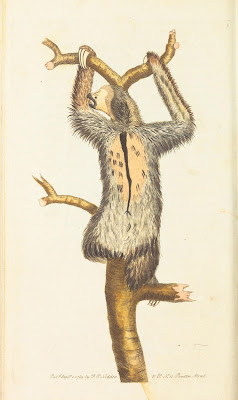 |
| Illustration from Kyle Goes Alone (Illustration: Ashley Barron) |
 |
| (Fernando Flores, Wikipedia) |
I've always liked sloths, those sleepy-eyed characters that hang upside with goofy grins on their faces, moving unbelievably slowly or not moving at all. I actually emulated sloths in my teens, at least that's what my parents suggested, though they usually just used the word "lazy."
 |
| (J.C.D. Schreber, Die Säugthiere in Abbildungen nach der Natur, 1855)* |
So I started reading about sloths and it wasn't long before I came across the kind of startlingly wonderful information that makes my heart sing: sloths only poop once a week. And why do they only poop once a week? Because sloths really are slow. In fact, not only are they so slow-moving that researchers' motion sensing cameras are sometimes not triggered when they pass, their digestive processes are the slowest of any mammal.
 |
| (Charles Dessalines d'Orbigny, 1849)* |
Sloths primarily eat leaves. Tree leaves, particularly thick, long-lasting tropical tree leaves, are not packed with nutrients, nor are they easy to digest since their cell walls are made up of cellulose and lignin—just like a tree's wood, bark and branches. The only way a sloth can digest this tough stuff is with the help of gut bacteria, and this process takes a long time—a single leaf can take a month to travel from one end of a sloth to the other!
 |
| (J.C.D. Schreber, Die Säugthiere in Abbildungen nach der Natur, 1855)* |
I also learned that some sloths add another fascinating bit of behaviour to this slow digestion. Three-toed sloths only poop on the ground, despite the ground being an unbelievably dangerous place to spend time for a creature whose hanging-upsidedown-from-trees anatomy is ill-suited to walking—more than half of all sloth deaths are caused by predation during these weekly excursions.
 |
| (1776)* |
And then I found this video of baby sloths being "potty trained" at a sloth rescue centre in Costa Rica—just about the cutest thing I've ever seen. And suddenly I wasn't working on the book I thought I was working on anymore. Now I was writing a picture book called Kyle Goes Alone (Owlkids Books, illustrated by the brilliant Ashley Barron), the story of a young sloth's first trip to the ground alone, cheered on by camouflaged rainforest neighbours. I managed to work much of the above sloth poop information into the book, but I didn't have room for the following, even more entertaining information.
 |
| Two-toed sloth (Albertus Seba, 18th Century)* |
Three-toed sloths carry their very own ecosystems in their fur coats. Their hair is grooved, and in the humid rainforests where they live, these grooves are a perfect place for algae to grow, algae that can be plentiful enough in the rainy season that a sloth can appear to be completely green—not a bad colour if you live amongst green leaves. Along with algae, sloth hair also harbours all kinds of fungi, ticks, mites, and insects. Some of the insects are moths that, as adults, live nowhere else other than between the hairs of a sloth's thick coat. Their other life stages—egg, larva, and pupa—are all spent in...drum roll, please...sloth poop.
 |
| (Frederick P. Nodder, 1789)* |
Here's how this works: The adult moths, which have no mandibles, so likely don't eat, hang around on a sloth, seeking out another moth of the opposite sex. Then they do what they're supposed to do, which is procreate. Pregnant females wait until that happy moment when the sloth's weekly urge to "go" drives it slowly down to the ground. Once on the forest floor, the sloth, which often carries around a third of its body weight in waste (imagine!!), uses its tail to carve a little hollow in the ground, then defecates. This is, of course, the moment the female moths are waiting for. They crawl out of the sloth's hair and flutter down to the hard pellets where they lay their eggs. Once the eggs hatch, the larvae have ample food, particularly since they have the advantage of having arrived before any other forest dung-eaters. They eat to their hearts' content and then pupate. When an adult emerges, it flies upwards to search out some sloth fur to take up residence and seek out a potential mate—a sloth that is likely to be the same one its parents lived on since these animals are very fond of certain trees and don't stray far from them.
 |
| (1889) |
 |
| (Maximilian Wied, Abbildungen zur Naturgeschichte Brasiliens, 1822) |
 |
| (Ashley Barron) |
Kyle Goes Alone (written by Jan Thornhill, illustrated by Ashley Barron), Owlkids Books, 2015
Baby Sloths get Potty Trained Video
*Many early animal illustrators never saw the animals they depicted, hence some pretty fabulous sloth pictures!
1 comment:
In writing Worms for Breakfast: How to Feed a Zoo, I wound up learning a lot about not only animals' eating habits, but their pooping habits. My favorite fact came from a zookeeper in a koala enclosure.She said she got pooped on a lot, since her charges live in trees, and therefore spend most of the day above her head. But she also said she didn't mind, because koala poo was pretty dry and "ever so nice."
Post a Comment